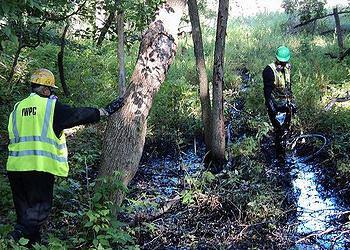 Vacuum crews work to remove Keystone tar sands oil near Kalamazoo River spill. Photo credit US EPA
Vacuum crews work to remove Keystone tar sands oil near Kalamazoo River spill. Photo credit US EPA
When the Longhorn pipeline was proposed in 1998, Austin, Texas citizens filed a lawsuit to assure protection of their Austin aquifer. By the time construction started, the operator had been forced to add $60,000,000 in safety features, meaning that the intention had been to cut $60,000,000 worth of corners that would have protected the environment.
Today, many consider the pipeline the safest in the state, maybe the safest in the US.
TransCanada plans to lay Keystone XL across the 20-mile stretch of one of the largest aquifers in the world, the Ogallala/High Plains Aquifer, which runs through eight states and is the source of 30% of our nation’s irrigation water.
Despite the original Keystone’s having leaked 1,000,000 gallons of tar sands crude into the Kalamazoo River in 2010, despite having caused more than a dozen spills in 2011—including a six-story geyser in Nebraska—TransCanada’s Keystone XL plans call for using only standard, rather than advanced, leak detection technology across the Ogallala, thus making bigger leaks more likely.
Inside Climate Change reports, “The leak detection technology that will be used on the Keystone XL is standard for the nation’s crude oil pipelines and rarely detects leaks smaller than 1% of the pipeline’s flow. Keystone XL will have a capacity of 29,000,000 gallons per day—so a spill would have to reach 294,000 gallons per day to trigger its leak detection technology.
“Keystone XL also won’t get two other safeguards found on Austin’s aqu1fer: a concrete cap that protects the Longhorn from construction-related punctures, and daily aerial or foot patrols to check for tiny spills that might seep to the surface.”
The 20-mile stretch of most concern lies in Nebraska where the aquifer is only 20’ beneath the surface, making it most vulnerable to contamination from spills. Ranchers depend on it for a supply of fresh water.
Adding external sensor cables, a concrete cap and extra patrols for the 20-miles would cost TransCanada only 0.2% of Keystone’s $5.300,000,000 budget. But the company refuses to do so, adding the assurance that Keystone XL pipeline would “meet or exceed” safety standards. Their plans include none of the safeguards that protect the Austin aquifer.
We’ve seen the devastating effect of the 2010 tar sands crude spill in the Kalamazoo River, but little is known about the effect of a similar spill in an aquifer.
Wayne Woldt, a University of Nebraska-Lincoln professor who studies groundwater management predicts, “Once an aquifer is contaminated, it’s virtually impossible to restore it to its pristine condition.” The extent of damage would depend on the size of the spill and on how the tar sands crude moves within the aquifer.
My Take on the situation: The standard leak detection technology TransCanada intends to use in Keystone XL is adequate for the standard crude oil that regularly flows through existing US pipelines.
But there’s nothing standard or regular about tar sands crude crud or about the way it oozes through pipelines.
NASA climate scientist James Hansen calls the Keystone XL a “fuse to the biggest carbon bomb on the planet.”
Not to worry. The integrity of the pipeline lies in the oily hands of TransCanada, truly a green-thinking company: the green of US dollars.
Source: ThinkProgress, December 18, 2012 Inside Climate News, December 20, 2012
